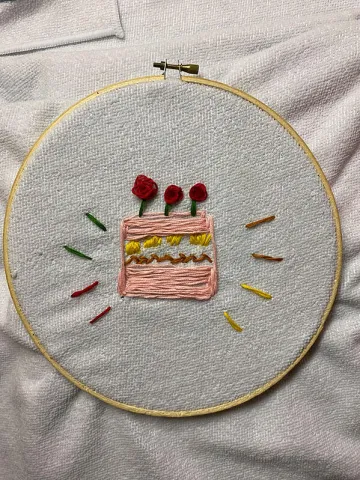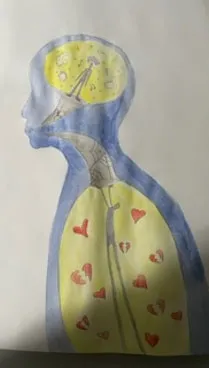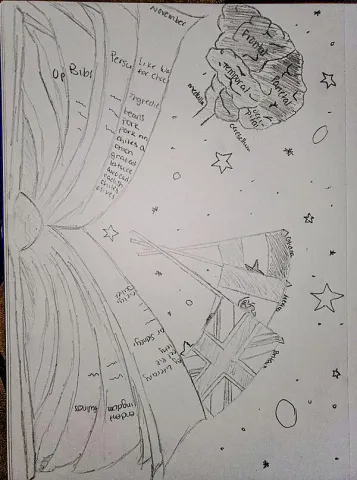What is Bibliotherapy? Students Explore Books as Therapy in Lit Class
What is bibliotherapy? Read about a unique literary conflicts course at Saint Leo University in which students explored the concept of reading fiction as therapy.

What is bibliotherapy? Read about a unique literary conflicts course at Saint Leo University in which students explored the concept of reading fiction as therapy.

Dr. Kathryn Duncan has a knack for creating innovative literature courses. This past fall, the Saint Leo University English professor transformed a literary conflicts course into an academic journey that explored how using literature rooted in both internal and external conflicts can help readers overcome struggles through a concept called bibliotherapy.
According to Duncan, the timing of the course could not have been better.
“We’re in such a difficult time right now in the world, so I wanted to address this in a way that is more therapeutic for students,” Duncan says.
Fittingly, she recently published a book called Jane Austen and the Buddha: Teachers of Enlightenment. A work of literary criticism, it explores the emotional benefits of reading Austen’s 19th-century works. She also completed an online course on bibliotherapy earlier this year.
Duncan offers up her definition of the concept of this unique practice.
“I define bibliotherapy as the practice of prescribing books to help individuals with emotional challenges,” she says. “This includes many mental health struggles. The concept is definitely more popular in the UK, but I think it’s starting to gain some traction in general. Mental health specialists often suggest self-help books, and these work well in many cases. But there’s another angle of advising people to read fiction for therapy. If we can relate to a character who is going through struggles and then see how they overcome them, we may feel less alone in our lives.”
Additionally, she underscores the parallels between reading and empathy.
“Research shows that reading fiction does increase empathy,” she says. “When we read, our brains light up as if we’re practically acting out what the characters are doing in the stories we read. This is why reading fiction can actually change our neural patterns for the better.”
For the literary conflicts course, she chose four books to focus on: The Guernsey Literary and Potato Peel Pie Society by Mary Ann Shaffer and Annie Barrows (2008); Persuasion by Jane Austen (1817); Like Water for Chocolate by Laura Esquivel (1989); and Transcendent Kingdom by Yaa Gyasi (2020). The students also looked at some poetry.
“I thought all of these works would be great examples of fiction that can be used in bibliotherapy,” she explains.
One assignment was for the students to choose a character from Transcendent Kingdom and ‘prescribe’ three works of fiction for that particular character to read. The works had to be based on the concept of bibliotherapy to help the character overcome his or her struggles.
The students also had to create some type of art expressing one of their passions and then write a short paper describing its significance. Duncan says this idea was born out of Like Water for Chocolate.
“The main character in this book, Tita De La Garza, is going through an external conflict because of the Mexican Revolution going on. She is also dealing with an abusive mother who tells her she must never marry and care for her. She turns to cooking as a way to cope with her struggles. So, I asked the students about what feeds or nurtures them in terms of passions or hobbies.”
The students were not graded on the actual creative project but did receive a grade on the paper about it. Students submitted everything from embroidery to dancing to visual art to baking to music.
“I wanted the students to learn about the idea of what it is that taps into the concept of creative problem solving and then how to take these strategies to navigate external conflicts in their lives.”
Other activities included having the students handwrite actual letters to put in a stamped envelope, engage in a walking meditation exercise, and doodle with crayons with music from the Harry Potter films playing in the background.
Unlike many college courses, this class did not include any exams on the syllabus. According to Duncan, this was absolutely intentional.
“Our education system tends to be so standardized and locks students into very specific requirements. I believe we should think outside the box and let students explore their own creativity and passions.”
She cites Ellen Langer, a prominent social psychologist who some consider the ‘mother of mindfulness,’ when explaining the idea of allowing students to learn in a way that best fits their individual abilities.
“Langer talks about how ‘mindlessness’ is so prevalent in education and the fact that exams assess all students across the board, leaving creativity and thinking outside the box completely out of the picture,” Duncan explains.
And what does she think the students learned most from the course?
“In today’s society, we’re dealing with so many challenges, and we all experience stress in different ways,” she says. “I think through the literature we studied, they learned to sit better with their discomfort.”
The undergraduate literary conflicts course, which was held at University Campus, had 12 students, exemplifying the small class sizes offered by Saint Leo University in general.
Khamille Labbe, a 20-year-old student in the class, originally comes from Puerto Plata, Dominican Republic. An alumna of Cutler Bay Senior High School in Miami, FL, she discovered Saint Leo University at a college fair while just a sophomore in high school.
“College was always a dream of mine, but I didn’t think I could afford it because my mom raised me from the time I was nine.”
She initially attended Miami-Dade College where she took a handful of classes before transferring to Saint Leo. She says she was fortunate to receive the Presidential Transfer Award, a scholarship which covers up to $12,000 in tuition each year for undergraduate transfer students. She has also received other smaller scholarships.
Labbe is working toward a bachelor’s in English focusing on professional writing. In middle school, she read the poem “Annabel Lee” by Edgar Allan Poe and walked away with the motivation to eventually pursue English as a college major.
“It was so powerful and inspirational that I wanted to write like that and evoke the same emotion in readers like the emotion I felt after reading it,” Labbe confides.
She also took a literature class at Saint Leo with Dr. Allyson Marino in which she had to write a paper based on the concept of autoethnography.
“This paper really allowed me to do a lot of self-reflection in an academic setting,” she recalls.
In terms of Duncan’s literary conflicts class, Labbe admits she had never heard of bibliotherapy before.
“My mind was blown,” she says. “Reading can help you do so many things. I wish more people knew about this concept. Everyone assumes there’s a social standard to see a therapist and take medication. I think these are great strategies, but you can work on healing within yourself. I told Dr. Duncan her class is like my therapy.”
In her research paper on bibliotherapy, she focused on Gifty, the main character in Transcendent Kingdom to whom she can relate as an immigrant.
“As immigrants, it’s so easy to fall into assimilation and give up on our culture.”
She can’t use enough positive adjectives to describe her experience in such a unique course.
“This wasn’t your average English class,” she says. “Dr. Duncan reminds us that we’re more than just college students. I don’t know how the Nobel Peace prize works, but I think Dr. Duncan should get one. I’ve never felt so calm and relaxed in any other class I’ve taken. I’d take this class 100 times over again if I could.”
Ryn Williams, also 20 and a native of Tampa, FL, is a 2019 alumna of Pasco High School who took the literary conflicts course. She completed her associate degree from Pasco-Hernando State College, a degree she began working on in high school. She enrolled at Saint Leo in the fall of 2020.
A double major working toward her bachelor’s in English with a professional writing focus and a bachelor’s in medical humanities in the health humanities track, she works as the layout editor for The Lions’ Pride student newspaper.
“Dr. Duncan is such an innovative professor,” Williams shares. “I felt so much more connected to the books in this class because of all the fun activities we engaged in that were related to the texts. She is kind of inspiring to me because if she can design literature classes on Harry Potter, pirates, or monsters, it takes a lot to come up with those ideas.”
While her two majors may seem quite different, she has found some overlap.
“In medical humanities, we look at a patient as an individual rather than only their symptoms,” she says. “I was able to incorporate this approach into the bibliotherapy paper of assigning readings to a character based on that individual character as a person. Bibliotherapy is not an antibiotic. It’s more of a mental, emotional, and spiritual treatment.”
Other Saint Leo English professors whose classes she has enjoyed include Drs. Valerie Kasper, Allyson Marino, and Lee Hobbes.
“All of my professors have allowed me to be creative and open minded in their classes, as long as I justify a good reason for my ideas.”
Below are a few examples of the creative projects the students completed for this course with portions of their reflection papers explaining their ideas behind these projects.

“In embroidering the piece of cake, I want to explore the theme of magical realism in food. As we know, Tita cooks as a means to find comfort throughout a series of challenging situations. Everything she cooks brings on a powerful effect, whether physically or emotionally, on whomever eats it. I decided to do an embroidered piece because it forced me to create something with my hands, the same way Tita cooked every meal. I wanted to do something to relate to Tita. Although I am not a master embroiderer, I put my heart into my work – feeling happy to end the semester with a project I had fun with rather than be stressed out about.Each color, pattern, and overall design was directly inspired by our book, Like Water for Chocolate.”

“For the creative project, I wanted to show a passion of mine which is art and drawing. I got some inspiration from the class, as you’ll notice in my drawing. I included some cobwebs to incorporate some of those class ideas in there, as well as TikTok which I used for some ideas on how I would go about drawing those emotions. I felt like Tita was dealing with heartbreak, pain, and depression, all while enjoying her cooking. So, some choices I made for the drawing were to represent what was going on inside her heart and what was going on inside her head. Tita was a busy bee. She had a lot going on in her mind with all those recipes she memorized and those steps she recalled. As you’ll notice in my drawing, I have represented that same chaos inside her mind, but to get there, you really can’t as her throat is closed off by cobwebs from never being used. She was never able to speak her mind. But, as you can see, her mind is filled with life and color. It needs to be expressed yet she cannot with all the blockage created. In her heart, there is conflict. Whenever Pedro feels like giving her attention, she feels whole again, yet whenever he drifts away from her, she feels empty inside. Again, her throat is blocked from being able to express this pain to anyone besides herself. I also represented her heart as a person trying to get out with no key.”

“My aim was to depict the accumulation of what we read and discussed. I wanted my audience to have an instant image in their head when thinking about the literary conflicts course. The three flags are from Britain, Ghana, and Mexico, the settings for the works we read. The book itself is more of a general book and is supposed to represent all books. it's up to the audience to decide what type it is which is why the cover is not shown. The pages have writing and titles of what we read in class, ranging from the novels to the more academic subjects. Even the brain has symbolism in how reading incites physiological responses in people. As for the stars and glitter, they're supposed to represent fantasy and imagination coming out of the book.”